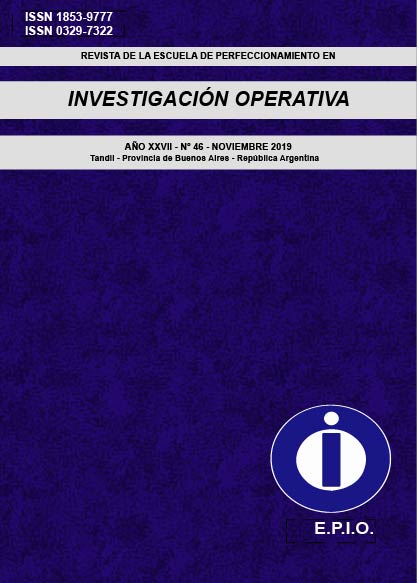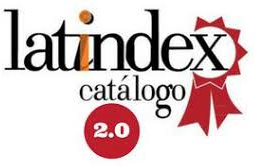Conocimientos previos sobre propiedades de operaciones con números reales de ingresantes a la universidad. Su análisis usando análisis estadístico implicativo
Keywords:
análisis estadístico implicativo cuasi-implicaciones operaciones con números reales evaluación de ingresantesAbstract
This work’s objective is to determine how knowledgeable new university students are regarding the properties of operations with real numbers (addition, multiplication, exponentiation and nth root) and what relations they establish between the knowledge that they have acquired in their pre-university education. In order to accomplish the planned objectives, in this work, via use of Statistical Implicative Analysis (SIA), the answers provided to a questionnaire found in a test of previous real numbers knowledge that was taken by new students of Facultad de Ciencias Exactas–UNNE (at the beginning of the academic year of 2017)were analyzed. SIA is a multivariate analysis technique that allows relations of type “if p, then, almost q” (quasi-implications or rules) between variables (the answers provided to the previously-mentioned question) to be established. These relations allow for exploration of the conceptual relations established by the analyzed subject and detect the cognitive difficulties that said concepts offer. The results are represented and visualized by use of an “implicative graph” and later bysimilarity and cohesitive trees that make possible the establishment of R-rules (quasi-implications that relate variables and rules or rules between each other). By observing the knowledge and conceptual relations established by the students, their lacking evolution from arithmetic thinking to algebraic is brought to light.
Downloads
References
ABRATE, R.; POCHULU, M.; VARGAS, J. (2006). “ERRORES Y DIFICULTADES EN MATEMÁTICA. ANÁLISIS DE CAUSA Y SUGERENCIAS DE TRABAJO”. Buenos Aires, Argentina: Universidad Nacional de Villa María. 198 páginas.ISBN-10: 987-98292-9-8; ISBN-13: 978-987-98292-9-5.
BODIN, A. (1995). “ANALYSE IMPLICATIVE: MODÈLES SOUS-JACENTS À L’ANALYSE IMPLICATIVE ET OUTILS COMPLÉMENTAIRES”. Publications de l’Institute de RechercheMathématiques de Rennes, fascicule 3 “FASCICULE DE DIDACTIQUE DE MATHÉMATIQUES I’E.I.A.O.” exp nº 3, pp 1 – 23.
CAPUTO, L.; JORGE, M.; ESPINOZA, R.; PORCEL, E.; ROMERO, J. (2016). “ANÁLISIS ESTADÍSTICO IMPLICATIVO DE LOS CONOCIMIENTOS PREVIOS SOBRE NÚMEROS REALES DE INGRESANTES A LA UNIVERSIDAD”. Cadernos do IME – Série Estatística.Volumen 42, p 30 – 44. Río de Janeiro, Brasil: Universidade do Estado do Rio de Janeiro. ISSN impreso 1413 – 9022. ISSN on line 2317 – 4535.
COUTURIER, R. (2009). “CHIC: UTILIZACIÓN Y FUNCIONALIDADES”. En TEORÍA Y APLICACIONES DEL ANÁLISIS ESTADÍSTICO IMPLICATIVO. PRIMERA APROXIMACIÓN EN LENGUA HISPANA. Compiladores: Orús, P.; Zamora, L.; Gregori, P. (Eds). Stgo de Cuba, Cuba: Universitat Jaume I de Castellón y Universidad de Oriente. pp 51 - 64.
GRAS, R.; KUNTZ, P. (2009). “EL ANÁLISIS ESTADÍSTICO IMPLICATIVO (ASI) EN RESPUESTA A PROBLEMAS QUE LE DIERON ORIGEN”. En TEORÍA Y APLICACIONES DEL ANÁLISIS ESTADÍSTICO IMPLICATIVO. PRIMERA APROXIMACIÓN EN LENGUA HISPANA. Compiladores: Orús, P.; Zamora, L.; Gregori, P. (Eds). Stgo. de Cuba, Cuba: Universitat Jaume I de Castellón y Universidad de Oriente. pp 3 – 50.
RÉGNIER J.C. (2013). Extracto de la obra “ANALYSE STATISTIQUE IMPLICATIVE. UNE MÉTHODE D'ANALYSE DE DONNÉES POUR LA RECHERCHE DE CAUSALITÉS”.Gras, R.; Régnier J.C.; Guillet F. (Eds) (2009).Web:http://sites.univ-lyon2.fr/asi7/?page=0&lang=es . Accedido:29/02/16.
SPAGNOLO, F.; GRAS, R.; RÉGNIER, J.C. (2009). “UNA MEDIDA COMPARATIVA DE LAS MATEMÁTICAS ENTRE EL ANÁLISIS A PRIORI Y LA CONTINGENCIA”. En TEORÍA Y APLICACIONES DEL ANÁLISIS ESTADÍSTICO IMPLICATIVO. PRIMERA APROXIMACIÓN EN LENGUA HISPANA. Compiladores: Orús, P.; Zamora, L.; Gregori, P. (Eds). Universitat Jaume I de Castellón (España) y Universidad de Oriente (Cuba). pp 143 – 158.
Downloads
Published
Issue
Section
License
Atribución — Usted debe dar crédito de manera adecuada, brindar un enlace a la licencia, e indicar si se han realizado cambios. Puede hacerlo en cualquier forma razonable, pero no de forma tal que sugiera que usted o su uso tienen el apoyo de la licenciante.
NoComercial — Usted no puede hacer uso del material con propósitos comerciales.
CompartirIgual — Si remezcla, transforma o crea a partir del material, debe distribuir su contribución bajo la misma licencia del original.







